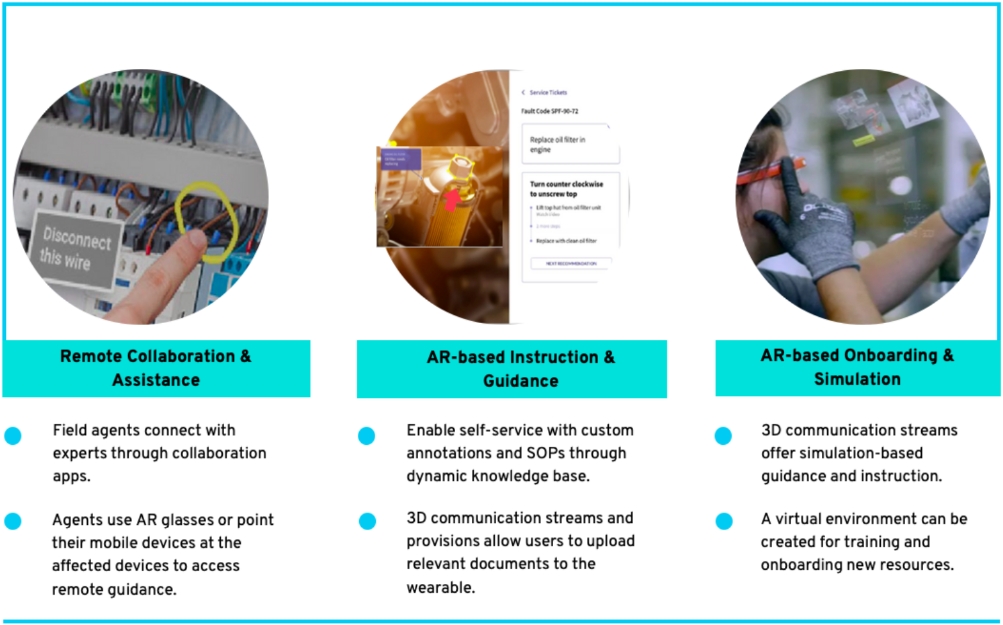In the evolving landscape of digital workplaces, efficient field service operations are critical to ensuring reduced downtime and high productivity with faster resolutions. Now more than ever, organizations are looking for effective ways to enhance field services. One such way is the shift-left approach using augmented reality (AR).
Evolving expectations in field service management
The field service management industry is growing. Its estimated market size of $3.24 billion (USD) in 2021 is expected to reach $8.06 billion in 2028, at a CAGR of 13.9%. At the same time, the industry has undergone massive changes over the last few years as the pandemic restricted in-person field service visits. To adapt to these changes, organizations have invested in emerging technologies such as artificial intelligence (AI), machine learning (ML), and augmented reality (AR) for remote service and predictive maintenance.
The adoption of advanced technologies is expected to drive industry growth, yet many organizations still follow a traditional approach to field services which is riddled with challenges that create problems for customers, the organization, and the field agents. Learning gaps between technicians, the dispatch of wrong equipment, and a shortage of experienced staff can increase the mean time to repair (MTTR), adding to customer frustration. In 2021, the cost of an hour of unplanned server downtime exceeded $300,000 for 91% of enterprises, and 44% of large enterprises claimed that one hour of unexpected downtime could cost their organization more than $1 million.
To remediate the problems associated with a traditional field services approach, organizations can adopt capabilities to enable lower-level employees (L1) to do the work typically done by higher-level employees (L2, L3). This is called a shift-left approach.
Why shift left?
A shift-left approach essentially brings processes, technologies, and experts closer to the customer, supporting self-service, optimizing processes, and increasing efficiency.

The pandemic has accelerated digitalization across all industries, and customers have started expecting more personalized, faster digital service solutions. The shift-left approach can benefit field service companies and their customers, but how do organizations implement the approach? The answer lies in the adoption of modern technologies such as AR.
Transforming field service by shifting left using AR
AR applications on mobile devices, tablets, wearables can enable customers to solve issues independently or collaborate remotely with technicians who can help them navigate the issue. Customers can say goodbye to bulky manuals and lengthy instructions, which can be replaced by immersive information provided with the help of AR.

AR-enabled devices powered by AI can further enhance capabilities, offering field service agents and customers elevated support.
The diagram below illustrates how AR-based solutions can support key aspects of field services.

AR-based solutions can be applied throughout industries, to both IT and non-IT devices, delivering significant value to field service organizations and the operations they support.
Using live visual interactions, easy integrations, self-guided instructions, and contextual insights, AR solutions can empower field agents to detect and resolve problems efficiently and boost remote solve rates, leading to reduced MTTR, higher FTRs, and lower skill gaps. Optimized field scheduling from L3/2 to L1 and enhanced onboarding through AR solutions can also lead to reduced operational expenses. AR solutions enable field agents to streamline their workflows and work more effectively, resulting in improved efficiency and higher customer satisfaction.
Wipro is embracing this innovation by teaming up with pioneering tech partners such as CareAR. You can learn more about our AI and AR solutions at Wipro Holmes.
Industry :

Sidharth Mukherjee
GM and Practice Head, Digital Workplace Services
Sidharth Mukherjee (Sid) is a dynamic leader and a true technology enthusiast at heart. He has more than 18 years of experience driving cutting-edge cloud and infrastructure services transformations for Fortune 500 organizations.
Sid has a passion for delivering “what’s next” and improving “what’s now” for enterprise technology, while keeping a keen focus on employee experience and innovation. He has an academic background specializing in IT and management, and is currently focused on harnessing the power of AI, cognition, blockchain, and analytics to create an intricate workspace metaverse aligned with the future of work. He is an alum of IIM Ahmedabad and specializes in business strategy, IT, and management.

Ravi Advani
VP of Industry Solutions at CareAR
Ravi is VP of Industry Solutions at CareAR, A Xerox Company, and is responsible for GTM through global channel partner ecosystem, delivering consistent growth, value, and innovation to customers for successful transformation of their businesses.
With over two decades of experience in managed services, leadership roles in digital workplace services and solutions management and digital transformation, Ravi is passionate about the future of work, and about applying technology and services solutions to deliver superior user experience and drive business outcomes.